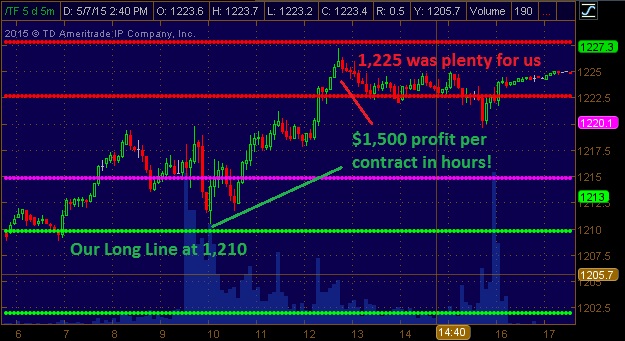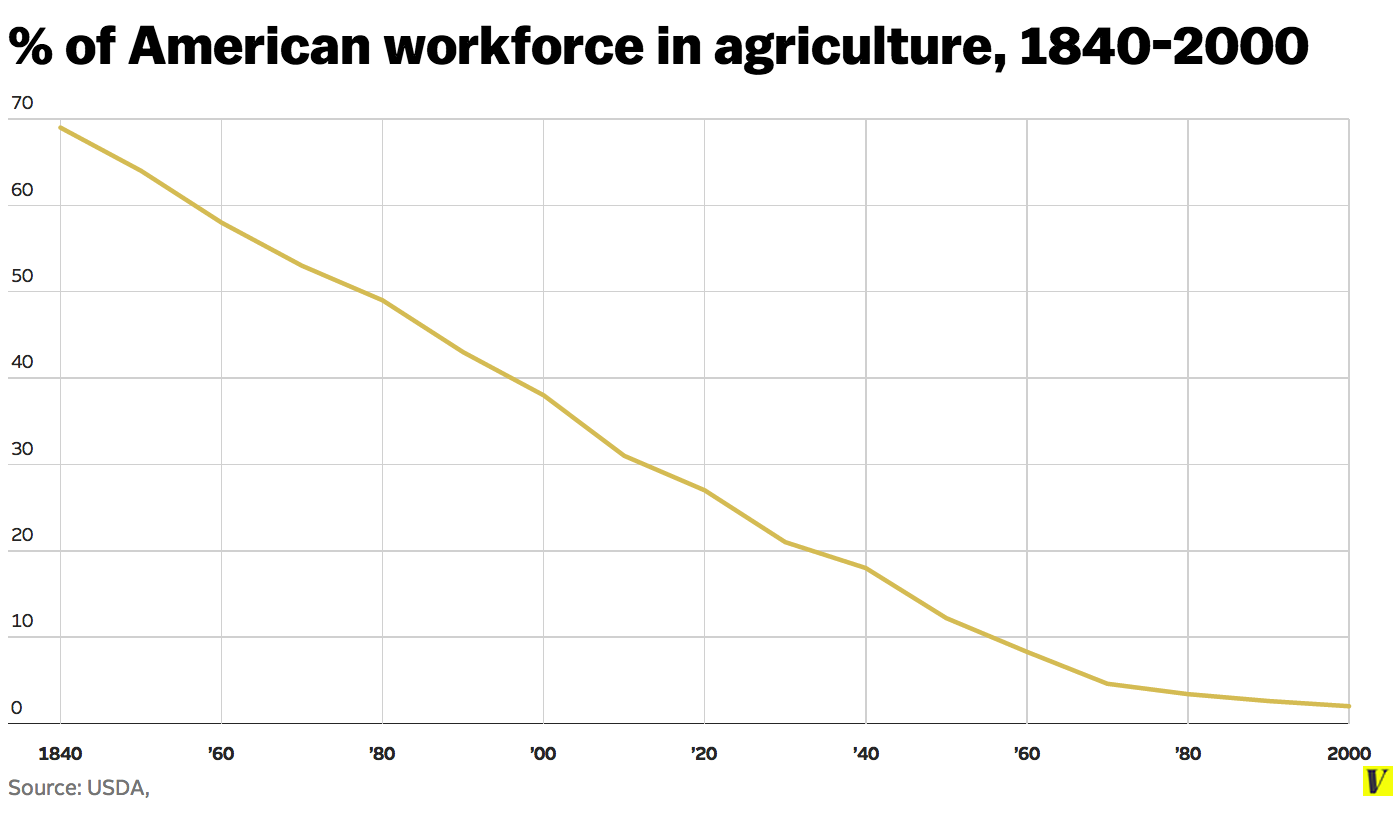 Wheeeeeeeeeeee!
Wheeeeeeeeeeee!
What a ride again on the stock market roller coaster. Our short position in oil continued to crank up the cash as crude fell to $58.50, up $3,500 per contract from our call to short on Wednesday morning, where we were EMPHATIC about the shorting opportunity (and you can have these reports delivered to you, pre-market, every day by simply clicking here). It's OK if you missed that chance to make $3,500 because the /ES (S&P Futures) longs I called for in yesterday's morning post finished the day at 2,085 for a $1,250 per contract gain and the /TF (Russell Futures) longs we called at 1,210 finished the day at 1,225 for a $1,500 per contract gain.
 We're not playing the Futures into the Non-Farm Payroll Report at 8:30 but we have leaned back to short in our Short-Term Portfolio, which took a $3,900 (3%) hit on yesterday's bounce because we left our aggressive shorts in place as the market rose (offset by our Futures longs, which don't track as portfolio profits as not everyone plays the Futures). For the advanced traders, the system worked perfectly, with the Futures gains offsetting the losses on the bearish hedges.
We're not playing the Futures into the Non-Farm Payroll Report at 8:30 but we have leaned back to short in our Short-Term Portfolio, which took a $3,900 (3%) hit on yesterday's bounce because we left our aggressive shorts in place as the market rose (offset by our Futures longs, which don't track as portfolio profits as not everyone plays the Futures). For the advanced traders, the system worked perfectly, with the Futures gains offsetting the losses on the bearish hedges.
As you can see from Dave Fry's SPY chart, yesterday was another low-volume, BS rally that stopped right after the EU closed (11:30), so most likely panic money coming in from overseas, where the Union may collapse over the weekend if Greece isn't extended again.
Greek Finance Minister Yanis Varoufakis said his government is prepared to go “down to the wire” in talks with its creditors as policy makers signal they’re losing patience with the country after months of brinkmanship. Varoufakis, who denies he’s been sidelined by Greek Prime Minister Alexis Tsipras in the negotiations, said he expects an agreement in the next two weeks, though one is unlikely to be announced when euro-area finance chiefs meet on Monday.
 That's not even what's bothering me, Globally. What's got me worried is still China, and their rapidly expanding debt. Just 10 years ago, China was running a surplus and had just over $100Bn in total debt. Now China's debt has surpassed the US ratio (their GDP is 1/2 our size).
That's not even what's bothering me, Globally. What's got me worried is still China, and their rapidly expanding debt. Just 10 years ago, China was running a surplus and had just over $100Bn in total debt. Now China's debt has surpassed the US ratio (their GDP is 1/2 our size).
Total debt has reached 282 percent of GDP, according to the McKinsey Global Institute. While other big economies aren't far behind, it's the pace of China's credit expansion that's worrying policy makers, spurring targeted stimulus strikes while trying to avoid a debt sugar hit.
 While the bills are piling up in China, companies are beginning to default (see last week's posts), Municipal Government Bonds are being downgraded and the entire country is on credit watch while the Top 1% of China have run $300Bn out of the country in the past 6 months alone.
While the bills are piling up in China, companies are beginning to default (see last week's posts), Municipal Government Bonds are being downgraded and the entire country is on credit watch while the Top 1% of China have run $300Bn out of the country in the past 6 months alone.
China’s official foreign exchange reserves fell $260 billion between June and March. The investors moving money out include foreign hedge funds and Chinese individuals and companies, and the money leaves China in a variety of ways. Some escapes illegitimately, by skirting strict currency rules, and some of the transfers are approved by authorities—such as increased overseas lending by Chinese banks.
 If it continues, the exodus of funds will put the People’s Bank of China, the central bank, in a bind. China could retain some of this money by raising rates, but it’s leaning toward cutting them to stimulate growth.
If it continues, the exodus of funds will put the People’s Bank of China, the central bank, in a bind. China could retain some of this money by raising rates, but it’s leaning toward cutting them to stimulate growth.
“Expectations that there will be an interest rate cut in the near term are fermenting,” says Yu Pingkang, an economist at Huatai Securities in Shenzhen. Lowering the central bank’s benchmark lending rate would weaken the attractiveness of Chinese investments and possibly accelerate the outflow.
 Meanwhile, Chinese Imports fell 16.1% in April, the 4th consecutive month of double-digit declines. That's down about 50% for the year – no wonder we're short on FXI! Not only has China stopped buying things from overseas but overseas has stopped buying from them as Exports from China dropped 6.2% in April. That is NOT GOOD people – why are you not concerned? Why does the MSM ignore this?
Meanwhile, Chinese Imports fell 16.1% in April, the 4th consecutive month of double-digit declines. That's down about 50% for the year – no wonder we're short on FXI! Not only has China stopped buying things from overseas but overseas has stopped buying from them as Exports from China dropped 6.2% in April. That is NOT GOOD people – why are you not concerned? Why does the MSM ignore this?
Yes, things are so bad they must be GOOD, right? The Central Banksters will save us with MORE FREE MONEY but, clearly, more free money is not working and has not worked for quite a while now. As I said to our Members this morning in our Live Chat Room:
I mean, WTF?, right? America alone can't save China when Japan and Europe are dragging them down. There are 4 tires on the Global Car and it won't run on two flats. Keep in mind we're not shorting the markets (we have pokes on EWJ and FXI, but not major positions), we're just staying in CASH!!! to avoid the insanity. If the market doesn't make sense – don't play it. This one clearly doesn't.

If not for the incredible efforts of the Central Banksters to prop things up, I'd be shorting the crap out of things but you can't fight all G20 Feds – not when they are the ones measuring their own effect on things ("and it turns out we're doing a fantastic job!"). Don't forget, the mindset of the academics that work for the Capitalists is that it's the "animal spirits" that are to blame for a bad economy.

They concede that Consumer Spending is 70% of the economy because that's a measurement they can't deny but then it all goes wrong because economists think that if they can just "cheer up" the consumers – they will run out and spend money and work harder to pay their bills and the economy will soar. They think that because, for the last 150 years – that's the way things worked in a "Modern Economy".

That's because, like China more recently, for the last 150 years we have gone from 64% of the people farming to support 100% to 3M farmers now supporting 310M Non-Farmers. That's why today's Non-Farm Payroll report should just be called "Payroll".

So think about that, over 150 years (assuming steady population) over 1M people each year left the farm to join the labor force. Even as recently as 1980, there were still 6M farmers, 9M in 1970, 15M in 1960, 25M in 1950 and that's where we actually hit 1M per year (but with a smaller population). Actually, that's true – in the first 100 years, it was more like 2-3M per year (2% of working population) joining the labor force each year.

That has always kept labor costs low (constant influx) and kept productivity high but we are now past that phase. We technically passed that phase when we began needing immigrants to work farms, right? But the mindsets of economist are still based on the America they grew up in and they cling to old paradigms that are no longer valid.

That's why there is such "confusion" as to why dumping money into the economy isn't cheering people up – they simply don't understand the people anymore. The people are overworked and underpaid and don't have access to the capital the Central Banksters are pumping out. A cynic can argue the CB's are well aware of this and that they true purpose of QE is simply to steal money from future generations in each country and funnel it up to the Illuminati that charter the Central Banks. But I'm not a cynic so I'll just call them Economorons because they are dangerously clueless about how the Global Economy actually works in 2015.
Have a great weekend,
– Phil



